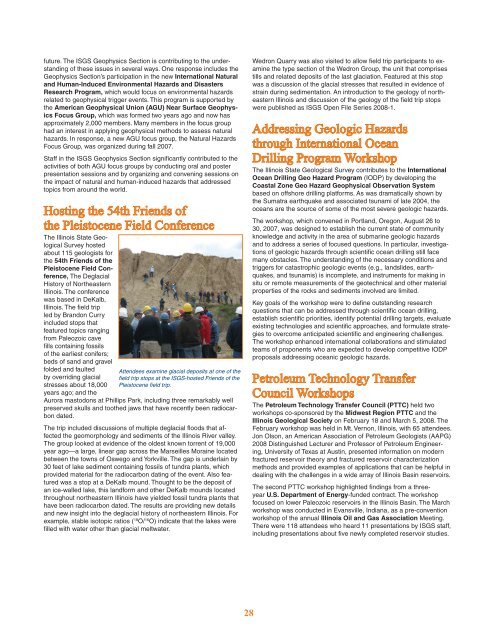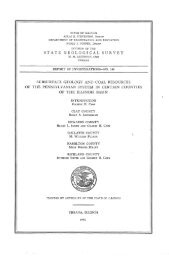2008 ISGS Annual Report - University of Illinois at Urbana-Champaign
2008 ISGS Annual Report - University of Illinois at Urbana-Champaign
2008 ISGS Annual Report - University of Illinois at Urbana-Champaign
You also want an ePaper? Increase the reach of your titles
YUMPU automatically turns print PDFs into web optimized ePapers that Google loves.
future. The <strong>ISGS</strong> Geophysics Section is contributing to the understanding<br />
<strong>of</strong> these issues in several ways. One response includes the<br />
Geophysics Section’s particip<strong>at</strong>ion in the new Intern<strong>at</strong>ional N<strong>at</strong>ural<br />
and Human-Induced Environmental Hazards and Disasters<br />
Research Program, which would focus on environmental hazards<br />
rel<strong>at</strong>ed to geophysical trigger events. This program is supported by<br />
the American Geophysical Union (AGU) Near Surface Geophysics<br />
Focus Group, which was formed two years ago and now has<br />
approxim<strong>at</strong>ely 2,000 members. Many members in the focus group<br />
had an interest in applying geophysical methods to assess n<strong>at</strong>ural<br />
hazards. In response, a new AGU focus group, the N<strong>at</strong>ural Hazards<br />
Focus Group, was organized during fall 2007.<br />
Staff in the <strong>ISGS</strong> Geophysics Section significantly contributed to the<br />
activities <strong>of</strong> both AGU focus groups by conducting oral and poster<br />
present<strong>at</strong>ion sessions and by organizing and convening sessions on<br />
the impact <strong>of</strong> n<strong>at</strong>ural and human-induced hazards th<strong>at</strong> addressed<br />
topics from around the world.<br />
Hosting the 54th Friends <strong>of</strong><br />
the Pleistocene Field Conference<br />
The <strong>Illinois</strong> St<strong>at</strong>e Geological<br />
Survey hosted<br />
about 115 geologists for<br />
the 54th Friends <strong>of</strong> the<br />
Pleistocene Field Conference,<br />
The Deglacial<br />
History <strong>of</strong> Northeastern<br />
<strong>Illinois</strong>. The conference<br />
was based in DeKalb,<br />
<strong>Illinois</strong>. The field trip<br />
led by Brandon Curry<br />
included stops th<strong>at</strong><br />
fe<strong>at</strong>ured topics ranging<br />
from Paleozoic cave<br />
fills containing fossils<br />
<strong>of</strong> the earliest conifers;<br />
beds <strong>of</strong> sand and gravel<br />
folded and faulted<br />
by overriding glacial<br />
stresses about 18,000<br />
years ago; and the<br />
Attendees examine glacial deposits <strong>at</strong> one <strong>of</strong> the<br />
field trip stops <strong>at</strong> the <strong>ISGS</strong>-hosted Friends <strong>of</strong> the<br />
Pleistocene field trip.<br />
Aurora mastodons <strong>at</strong> Phillips Park, including three remarkably well<br />
preserved skulls and toothed jaws th<strong>at</strong> have recently been radiocarbon<br />
d<strong>at</strong>ed.<br />
The trip included discussions <strong>of</strong> multiple deglacial floods th<strong>at</strong> affected<br />
the geomorphology and sediments <strong>of</strong> the <strong>Illinois</strong> River valley.<br />
The group looked <strong>at</strong> evidence <strong>of</strong> the oldest known torrent <strong>of</strong> 19,000<br />
year ago—a large, linear gap across the Marseilles Moraine loc<strong>at</strong>ed<br />
between the towns <strong>of</strong> Oswego and Yorkville. The gap is underlain by<br />
30 feet <strong>of</strong> lake sediment containing fossils <strong>of</strong> tundra plants, which<br />
provided m<strong>at</strong>erial for the radiocarbon d<strong>at</strong>ing <strong>of</strong> the event. Also fe<strong>at</strong>ured<br />
was a stop <strong>at</strong> a DeKalb mound. Thought to be the deposit <strong>of</strong><br />
an ice-walled lake, this landform and other DeKalb mounds loc<strong>at</strong>ed<br />
throughout northeastern <strong>Illinois</strong> have yielded fossil tundra plants th<strong>at</strong><br />
have been radiocarbon d<strong>at</strong>ed. The results are providing new details<br />
and new insight into the deglacial history <strong>of</strong> northeastern <strong>Illinois</strong>. For<br />
example, stable isotopic r<strong>at</strong>ios ( 18 O/ 16 O) indic<strong>at</strong>e th<strong>at</strong> the lakes were<br />
filled with w<strong>at</strong>er other than glacial meltw<strong>at</strong>er.<br />
28<br />
Wedron Quarry was also visited to allow field trip participants to examine<br />
the type section <strong>of</strong> the Wedron Group, the unit th<strong>at</strong> comprises<br />
tills and rel<strong>at</strong>ed deposits <strong>of</strong> the last glaci<strong>at</strong>ion. Fe<strong>at</strong>ured <strong>at</strong> this stop<br />
was a discussion <strong>of</strong> the glacial stresses th<strong>at</strong> resulted in evidence <strong>of</strong><br />
strain during sediment<strong>at</strong>ion. An introduction to the geology <strong>of</strong> northeastern<br />
<strong>Illinois</strong> and discussion <strong>of</strong> the geology <strong>of</strong> the field trip stops<br />
were published as <strong>ISGS</strong> Open File Series <strong>2008</strong>-1.<br />
Addressing Geologic Hazards<br />
through Intern<strong>at</strong>ional Ocean<br />
Drilling Program Workshop<br />
The <strong>Illinois</strong> St<strong>at</strong>e Geological Survey contributes to the Intern<strong>at</strong>ional<br />
Ocean Drilling Geo Hazard Program (IODP) by developing the<br />
Coastal Zone Geo Hazard Geophysical Observ<strong>at</strong>ion System<br />
based on <strong>of</strong>fshore drilling pl<strong>at</strong>forms. As was dram<strong>at</strong>ically shown by<br />
the Sum<strong>at</strong>ra earthquake and associ<strong>at</strong>ed tsunami <strong>of</strong> l<strong>at</strong>e 2004, the<br />
oceans are the source <strong>of</strong> some <strong>of</strong> the most severe geologic hazards.<br />
The workshop, which convened in Portland, Oregon, August 26 to<br />
30, 2007, was designed to establish the current st<strong>at</strong>e <strong>of</strong> community<br />
knowledge and activity in the area <strong>of</strong> submarine geologic hazards<br />
and to address a series <strong>of</strong> focused questions. In particular, investig<strong>at</strong>ions<br />
<strong>of</strong> geologic hazards through scientific ocean drilling still face<br />
many obstacles. The understanding <strong>of</strong> the necessary conditions and<br />
triggers for c<strong>at</strong>astrophic geologic events (e.g., landslides, earthquakes,<br />
and tsunamis) is incomplete, and instruments for making in<br />
situ or remote measurements <strong>of</strong> the geotechnical and other m<strong>at</strong>erial<br />
properties <strong>of</strong> the rocks and sediments involved are limited.<br />
Key goals <strong>of</strong> the workshop were to define outstanding research<br />
questions th<strong>at</strong> can be addressed through scientific ocean drilling,<br />
establish scientific priorities, identify potential drilling targets, evalu<strong>at</strong>e<br />
existing technologies and scientific approaches, and formul<strong>at</strong>e str<strong>at</strong>egies<br />
to overcome anticip<strong>at</strong>ed scientific and engineering challenges.<br />
The workshop enhanced intern<strong>at</strong>ional collabor<strong>at</strong>ions and stimul<strong>at</strong>ed<br />
teams <strong>of</strong> proponents who are expected to develop competitive IODP<br />
proposals addressing oceanic geologic hazards.<br />
Petroleum Technology Transfer<br />
Council Workshops<br />
The Petroleum Technology Transfer Council (PTTC) held two<br />
workshops co-sponsored by the Midwest Region PTTC and the<br />
<strong>Illinois</strong> Geological Society on February 18 and March 5, <strong>2008</strong>. The<br />
February workshop was held in Mt. Vernon, <strong>Illinois</strong>, with 65 <strong>at</strong>tendees.<br />
Jon Olson, an American Associ<strong>at</strong>ion <strong>of</strong> Petroleum Geologists (AAPG)<br />
<strong>2008</strong> Distinguished Lecturer and Pr<strong>of</strong>essor <strong>of</strong> Petroleum Engineering,<br />
<strong>University</strong> <strong>of</strong> Texas <strong>at</strong> Austin, presented inform<strong>at</strong>ion on modern<br />
fractured reservoir theory and fractured reservoir characteriz<strong>at</strong>ion<br />
methods and provided examples <strong>of</strong> applic<strong>at</strong>ions th<strong>at</strong> can be helpful in<br />
dealing with the challenges in a wide array <strong>of</strong> <strong>Illinois</strong> Basin reservoirs.<br />
The second PTTC workshop highlighted findings from a threeyear<br />
U.S. Department <strong>of</strong> Energy-funded contract. The workshop<br />
focused on lower Paleozoic reservoirs in the <strong>Illinois</strong> Basin. The March<br />
workshop was conducted in Evansville, Indiana, as a pre-convention<br />
workshop <strong>of</strong> the annual <strong>Illinois</strong> Oil and Gas Associ<strong>at</strong>ion Meeting.<br />
There were 118 <strong>at</strong>tendees who heard 11 present<strong>at</strong>ions by <strong>ISGS</strong> staff,<br />
including present<strong>at</strong>ions about five newly completed reservoir studies.

















